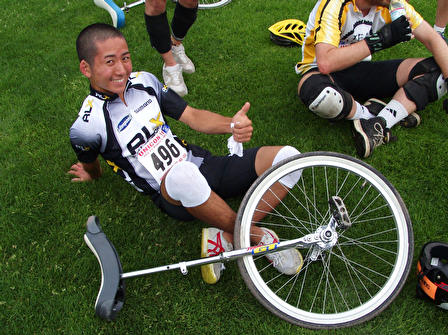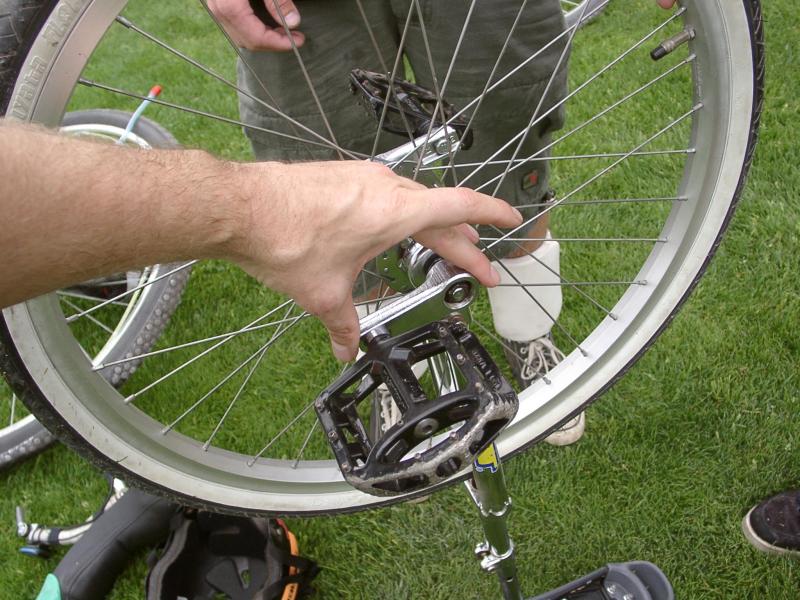Because the guy riding it pedaled really effing fast! There was another Japanese guy a few spots back in the race. I remember watching him ride in front of me for a while (me struggling to keep up on my 45" wheel with 6.5" cranks).
Unicycle races are won by athletes, not equipment. Have Roger and that guy switch unicycles, give them a month or more to practice, and I think Roger would probably still win.
Because in Japan you only race on 24" wheels. Though he could have brought a bigger one, I’m sure he a) didn’t own one, and b) wasn’t that interested in bringing a separate unicycle just for one race. In Japan it’s all 24" racing, except for possibly a very few specialty events, less than 1% of the racing done there.
I’m not bringing my Coker to Japan for the same reason. Though it would be the best cycle for that event, it’s not worth bringing it (especially at my mediocre training level) just for one race. We’re staying a week after Unicon as well, and then it would really be in the way.
When I went to Unicon III in 1987 (Tokyo), I had 5 unicycles and an artistic bike with me. This was because we paid for our trip by doing shows for a week before that in Hong Kong. I had so much luggage, the hotel had to remove the table and chairs from my room. Then bringing home three huge trophies and 8 or more little ones didn’t help…
For Japan, since I am not a trained-up top-level racer, I’m conserving luggage space. 29" is the wheel size of the future, mark my words. I will use mine for the new 700c races, then the 10k, and then the MUni events (with a tire change). I might have three different sets of cranks for it, but getting that to Japan will be so much easier than additional unicycles! I think I’m bringing just that one and a 20". No 24" at all! If I need to borrow one of those for a few minutes, there should be plenty of them laying around.
As somebody mentioned, the heavy Coker wheel is part of the problem. All that weight at a farther distance from the axle makes for a powerful flywheel effect. You reach a point of swiftly diminishing returns somewhere below 125mm on the cranks. Also the quality of the racecourse is a big factor.
I believe there is now a map on the Unicon XII web site showing the 10k course. It’s two loops with a tail on what may be a bike path. There sill be several sharp turns along the way, but I think it will be very flat, except for transition areas. I believe the bike path follows a waterway.
I bought a pair of prox. 66mm cranks (steel, clearly homemade) from Daiki Izumeda at Unicon 11. Never used them until I got my 29er, then put them on there for a laugh. I would not want to try to ride fast with those on there, as you have very little to work with. Too hard to adjust your speed. Even rocking was very interesting at first.
You can buy these cranks from MYS:
https://www.mys-co.com/shop_e/index.html
Click on the Parts button, then keep hitting “next” until you’re on page 5 of 7. You can get 50, 55, 60, 70, 80, 89, 95, and 102mm alloy cranks. They look like very nice cut-down jobs! I do not know how long it takes to ship them. I’m thinking of buying some when I’m there. If you plan to do this, they ask you to preorder, so they can make sure things are ready. These cranks might be made to order.
A geared-hub unicycle made by Greg Harper. Search on blue shift.


 ) but I’ve enjoyed it thoroughly, the best thing about it is it fits in the trunk of my tiny, tiny car however. Also, tubes and tires are numerous for it.
) but I’ve enjoyed it thoroughly, the best thing about it is it fits in the trunk of my tiny, tiny car however. Also, tubes and tires are numerous for it.